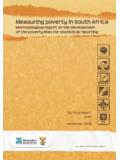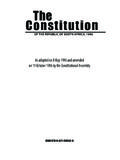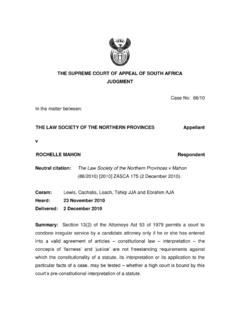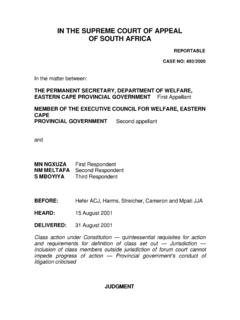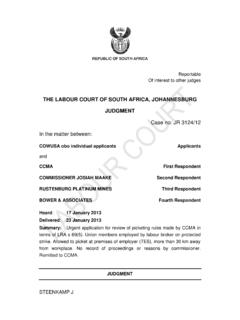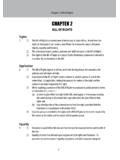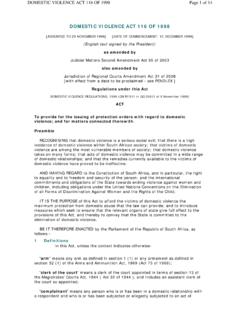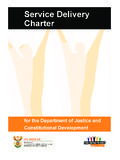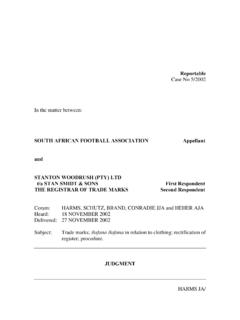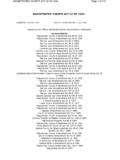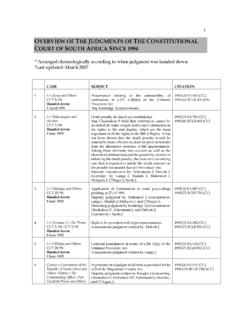Transcription of THE SUPREME COURT OF APPEAL OF SOUTH AFRICA
1 THE SUPREME COURT OF APPEAL OF SOUTH AFRICA Case No 176/2002 REPORTABLE In the matter between: A T W De Klerk Appellant and Absa Bank Ltd First Respondent Absa Insurance Brokers (Pty) Ltd Second Respondent Commercial Union Life Assurance Co of SA Ltd Third Respondent Neville G Du Toit Fourth Respondent Gert van Rooyen Fifth Respondent Before: Marais, Schutz, Cameron, Cloete JJA and Shongwe AJA Heard: 18 February 2003 Delivered: 6 March 2003 Absolution from the instance at end of plaintiff s case stringent test applied before granted damages loss of a chance to invest distinction between causation and quantification absolution set aside.
2 _____ JUDGMENT _____ SCHUTZ JA 2[1] Counsel who applies for absolution from the instance at the end of a plaintiff s case takes a risk, even though the plaintiff s case be weak. If the application succeeds the plaintiff s action is ended, he must pay the costs and the defendant is relieved of the decision whether to lead evidence and of having his body of evidence scrutinized should he choose to provide it. But time and time again plaintiffs against whom absolution has been ordered have appealed successfully and left the defendant to pay the costs of both the application and the APPEAL and with the need to decide what is to be done next. The question in this case is whether the plaintiff has crossed the low threshold of proof that the law sets when a plaintiff s case is closed but the defendant s is not. [2] The plaintiff is Mr De Klerk, a Pretoria attorney, who carries on practice as a firm styled De Klerk en Vennote.
3 His case was based on fraudulent or negligent misrepresentation, leading him to make a poor investment. The damages which he ultimately claimed were for the difference between what this investment yielded and the return that he would have obtained had the money so invested been available to be more fruitfully applied. Van der Walt J, sitting in the Transvaal Provincial Division, granted absolution on the ground that De Klerk had failed to lead any evidence that could prove his loss, particularly because he had not at all proved that he would have invested elsewhere had the money been available to him. Other grounds for absolution were also advanced. I shall deal with them later. 3[3] Before setting out the facts it is pertinent to repeat what was said by Schreiner JA in Gafoor v Unie Versekeringsadviseurs (Edms) Bpk 1961 (1) SA 335 at 340D-G: [O]n APPEAL it is generally right for the Appellate Tribunal, when allowing an APPEAL against an order granting absolution at the close of the plaintiff s case, to avoid, as far as possible, the expression of views that may prematurely curb the free exercise by the trial COURT of its judgment on the facts when the defendant s case has been closed.
4 Where, however, the issue turns on the interpretation of a document, the Appellate Tribunal, if it does not agree with the trial COURT s view that the interpretation of the crucial document is so manifestly in favour of the defendant as to justify the granting of absolution at the close of the plaintiff s case, should at least make its reasons clear enough to provide some assistance to the trial COURT in its eventual decision of the case. I think, however, that the Appellate Tribunal should preferably refrain from stating its reasons in such a way as to tie the trial Judge s hands unduly, for the proper interpretation of the document may be affected by circumstances appearing in the evidence led by the defendant. [4] Three witnesses gave evidence, De Klerk himself, Professor Marx, whose evidence may, in the circumstances, be ignored, and an actuary, Mr Gouws.
5 [5] De Klerk described how he was approached by a broker, Mr Du Toit (the fourth respondent and fourth defendant below). He was employed by United Insurance Brokers (Pty) Ltd (the second respondent and second defendant below now known as Absa Insurance Brokers (Pty) Ltd). I shall refer to this company as United Insurance . Du Toit requested to see him about an investment plan developed by United Bank Ltd ( United Bank the 4first respondent and first defendant below now known as Absa Bank Ltd) and Commercial Union Life Insurance Company of SA Ltd ( Commercial Union - the third respondent and third defendant below). De Klerk was not wholly won over by Du Toit as to the merits of the scheme, so Du Toit introduced Mr van Rooyen to confirm what he had said. Van Rooyen was the local manager of United Insurance and was later to be the fifth defendant and is the fifth respondent on APPEAL .
6 [6] In persuading De Klerk to invest Du Toit and van Rooyen made use of a brochure described as a Leningsrekening Delgingsplan under the name of Commercial Union. In the introductory part it describes all the disadvantages for a director of a company or for a proprietor of a professional firm if he makes long term loans to the company or firm. One of those is that if he takes interest it is taxable in his hands. Then, certain requirements for admission to the scheme are set out. De Klerk could meet them all. The workings of the scheme follow. United Bank will lend the firm (to take De Klerk s case) a sum equal to the proprietor s loan account for a fixed ten year period. The firm will pay interest to the bank on the loan for ten years. Such interest will be tax deductible. On receipt of the loan the firm will repay the proprietor s loan account.
7 He will then invest this sum in a specially evolved Prima-Groeiplan issued by Commercial Union. At the end of the ten years the Prima-Groeiplan is paid out to the proprietor free of tax. (Du Toit stated to De Klerk that the Receiver of Revenue had agreed to this.) The proprietor 5would then lend to the firm an amount equal to the original bank loan, which money would be used to discharge the bank loan. The difference between what the proprietor would receive from Commercial Union and the amount of the original bank loan would be retained by him free of tax. This would represent the proprietor s return after ten years. The other benefit offered (as already mentioned) was that the interest on the bank loan over ten years would be tax deductible. De Klerk said that it was those benefits that had persuaded him to invest.
8 [7] Paragraph 6 of the brochure proceeds with the statement that: Die volgende voorbeeld van n tipiese Leningsrekening-Delgingsplan sit duidelik uiteen hoe die plan werk sowel as die voordele vir beide maatskappy en direkteur (emphasis supplied). The brochure then states that in the example given it is assumed that the loan is for R100 000, that the proprietor will be 45 on his next birthday, that his marginal tax rate is 45 % and that the interest rate on the bank loan would be 15 %. The amount borrowed by De Klerk was R100 000, and although he would be 48 on his next birthday, Gouws gave evidence that the difference in age would result in the benefit being reduced by only some R5 000. The last phase of the example is depicted in paragraph 9. It shows an amount of R320 622 being paid to the proprietor after ten years, so that after paying off the bank loan of R100 000 he would be left with R220 622.
9 There follows the statement that one of the options open to the proprietor after ten years will be to retain the net amount remaining, ie R220 622, free of tax. 6[8] In the brochure there are no further qualifications to the statements to which I have referred. This is De Klerk s main complaint. He did not enquire into the internal workings of the scheme and relied on the assurances in the brochure as fortified by Du Toit and van Rooyen. In fact he says that both assured him that the R320 622 was a minimum amount but the payout might be more. [9] In contrast to the statements that De Klerk says were made to him in unqualified form is a document provided under discovery by Commercial Union, dated 7 October 1988. (The commencement date of the plan was 18 October 1988.) The document of 7 October bears the names of De Klerk and Du Toit, and it reflects the Illustrative Values on the Basic Plan after ten years as R244 823.
10 De Klerk says he knew nothing of this. Towards the end of the ten years Commercial Union wrote to De Klerk, on 12 October 1998, claiming that in 1988 it had sent a quotation to him which reflected an illustrative value of R244 823. De Klerk denies that he ever received such a quotation. At this stage of the case his denial must be provisionally accepted. [10] The correct approach to an absolution application is conveniently set out by Harms JA in Gordon Lloyd Page & Associates v Rivera and Another 2001 (1) SA 88 (SCA) at 92E-93A: [2] The test for absolution to be applied by a trial COURT at the end of a plaintiff s case was formulated in Claude Neon Lights (SA) Ltd v Daniel 1976 (4) SA 403 (A) at 409G-H in these terms: ..(W)hen absolution from the instance is sought at the close of plaintiff s case, the test to be applied is not whether the evidence led 7by plaintiff establishes what would finally be required to be established, but whether there is evidence upon which a COURT , applying its mind reasonably to such evidence, could or might (not should, nor ought to) find for the plaintiff.
